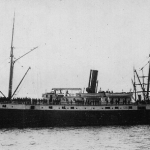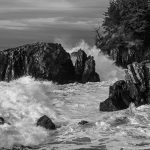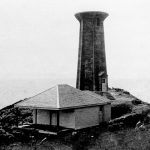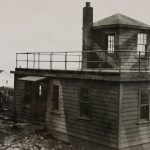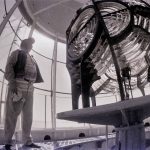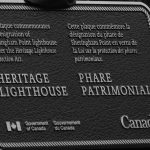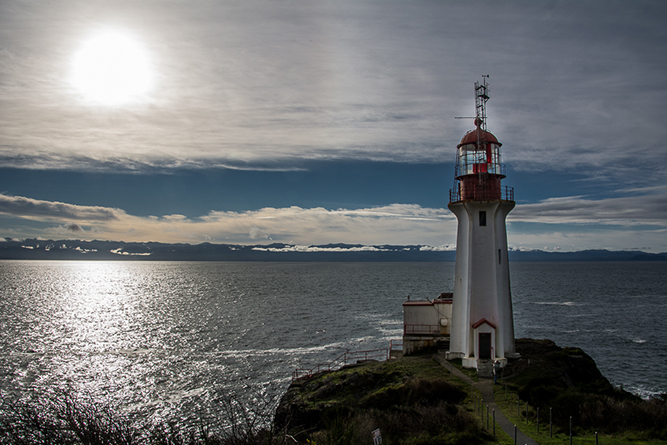LIGHTHOUSE HISTORY
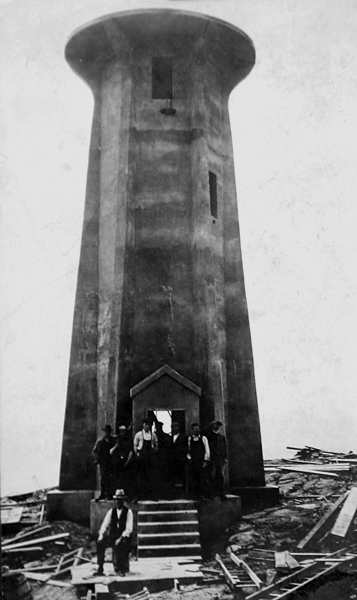
Over 100 Years of Service...
Standing 20 metres high, above the rocky coastline of southwest Vancouver Island, Sheringham Point Lighthouse has served as a beacon of hope and salvation for more than 100 years.
Built in 1912, Sheringham Point Lighthouse, like so many other lighthouses around our coastal waters, has saved countless lives throughout its history. Staffed for much of its life, the lighthouse was later automated and now has a single green beacon. It has provided navigational aid, weather information, solace and safety for mariners and those who make their living from the sea
Its history is rich and touches many families in this area. It is a reminder of our deep connections to the land and the sea, and it has always been seen as a symbol of security for our community.
RECOGNITION AND ACKNOWLEDGEMENT…
Human interaction with this site began long before the Lighthouse was constructed, even before European settlement of the area, as it was of significance to the local First Nations. Archaeological evidence has been discovered at the site indicating the connections and the First Nations’ use of the site over time. The T’Sou-ke First Nation continues to have an active relationship with the site, especially the adjacent property to the West. The Sheringham Point Lighthouse Preservation Society respects and honours our mutual history, and is pleased to work with the T’Sou-ke Nation to ensure that traditions and stories can be maintained and celebrated.
We recognize and acknowledge that this land remains unceded traditional territory of the T’Sou-ke First Nation, as well as the Pacheedaht First Nation, whose traditional territories met at Sheringham Point.
Chronology...
| DATE | ITEM/EVENT | DETAILS |
|---|---|---|
| Pre-history | First Nations Use of the Land | Specifics not known at this time, but archaeological sites identified on the foreshore. |
| 1778 | First European contact in British Columbia | In spring 1778, Captain James Cook became the first known European to set foot on what is now British Columbia. |
| 1790 | First maps of Southern Vancouver Island Coast | Manuel Quimper surveys and maps the area. |
| 1800's | Growth of maritime activity in area | Fur trading, a booming lumber industry and a series of gold rushes through the 1800s resulted in hundreds of shipwrecks along the Southwestern Coast of Vancouver Island. Area became known as the "graveyard of the Pacific". |
| 1843 | First European settlement on Southern Vancouver Island | James Douglas establishes Fort Victoria in Lekwungen Territory on Southern Vancouver Island. |
| 1846 | Sheringham Point named. | During a survey aboard the H.M.S. Herald, Captain Henry Kellet named Sheringham Point in honor of Commander William Louis Sheringham of the Royal Navy. |
| Feb 26, 1862 | Sinking of the bark "Anna Barnard" | En route from San Francisco to Sooke, the Anna Barnard struck rocks in thick fog and sank near Sheringham Point. |
| Jan 22, 1906 | Sinking of the SS Valencia | En route from San Fransisco to Seattle, the Valencia got lost in poor weather and ran aground near Pachena Point, with a loss of 137 lives |
| Feb-April,1906 | Commission of Inquiry into Valencia disaster | Both US and Canadian inquiries, recommending construction of additional lighthouses (including Sheringham Point). |
| July 30, 1910 | Purchase of Lot 82 | Edwin Clark purchases Lot 82 at Sheringham Point. |
| 1911 | Acquisition of land at Sheringham Point for Lighthouse. | Edwin Clark sells 4 acres of land at Sheringham Point to Government of Canada. |
| 1912 | Construction of Lighthouse. | Construction of Tower, boat house and lightkeeper's dwelling. |
| Sept 30, 1912 | Lighthouse illuminated for first time. | Lit by first lightkeeper Eustace Arden. Oil lamp with 3rd Order Fresnel Lens. |
| Dec. 2, 1912 | Grounding of County of Linlithgow | Vessel runs aground at Gordon's Beach due to mix-up with new Lighthouse. |
| 1913 | Request for road access | Arden requests road access to connect with West Coast Road. |
| 1917 | Supply ship SS Quadra sinks | Quadra hits another vessel in Nanaimo Harbour and sinks. Replaced by SS Estevan. |
| May 1, 1925 | Approval given for building of road access | Easement through Edwin Clark's land. |
| 1925 | Diaphone foghorn installed at site. | Included construction of fog-alarm building |
| 1931 | Road access to site completed. | Much of the work finally done by Arden and his sons. |
| 1941 | Additional 1.8 acres added to site. | Land added to the west of current site. |
| 1941 | Watch station and bunker added to site | Included barracks for a small group of signalmen stationed at the site. |
| 1946 | Eustace Arden retires as lightkeeper | Served for 34 years at Sheringham Point. |
| 1946 | Thomas Cross appointed as interim lightkeeper | Served in the position for 4 months. |
| 1946 - 1948 | Alfred Dickenson appointed as lightkeeper. | Dickenson served at 2 other lightstations prior to Sheringham Point. |
| 1948 | Thomas Westhead appointed lightkeeper. | Westhead served at 3 other lightstations prior to Sheringham Point. |
| 1954 | Final land addition to Sheringham Point site. | 2.5 additional acres purchased from Edwin Clark, to join together the previous two parcels. |
| 1959 | Fred Mountain appointed as lightkeeper. | Mountain served at 3 other lightstations prior to Sheringham Point |
| November 25,1967 | Fred Mountain dies while working at the Lighthouse site. | His cause of death is, at the moment, unspecified. |
| 1967 | Jim Bruton appointed as lightkeeper. | Bruton had previously served at 3 other lightstations. |
| 1976 | Fresnel Lens replaced with Crouse-Hinds DCB36 lens | New lens rotated electronically, allowing also for removal of mercury pan. |
| 1976 | Original fog-alarm building replaced with concrete block building (engine room). | Built inside of previous (wooden) building, and then previous structure removed. |
| 1980 | Original Fresnel Lens and Fog-horn donated to Sooke Museum | Included lens, foghorn, engine, compressor, tank and pressure gauge. |
| 1987 | Jim Bruton retires as head lightkeeper. | Family leaves site in 1987, although Bruton still "officially" on the payroll for about another year (accumulated vacation time). |
| 1987 | Kurt Cehak appointed lightkeeper, and moves on site with his wife Erika. | Cehak was previously stationed at Race Rocks and Entrance Island. Officially retired in 1985, but stayed on as a "relief" keeper. |
| 1987 (estimated) | Lighthouse tower receives extensive exterior restoration. | Date uncertain at this time. Estimated (late 1980s). |
| 1988 | Erika Cehak, officially appointed as head lightkeeper. | Due to administrative issues relating to Kurt's retired status, Erika was official named as lightkeeper. |
| 1988 | Sheringham Point Lighthouse "automated". | Formally automated on June 24, 1988. |
| 1989 | Sheringham Point Lighthouse "de-staffed", and Cehaks leave the site. | De-staffing occurred in late 1989, Cehaks left at beginning of 1990. |
| 1990 | Site secured and closed to public access. | As the site was, essentially, vacant, unauthorized access became quite commonplace. |
| 1997 | Vacant buildings burned down as a safety precaution. | Included lightkeepers dwelling, storage shed, garage and fallout shelter. |
| 2000 | Bill S-21, to protect Canadian Lighthouses first introduced in Canadian Senate. | Introduced by Sen. Mike Forrestall of Nova Scotia, with support of Sen. Pat Carney of BC. |
| 2003 | Sheringham Point Lighthouse Preservation Society founded to "preserve and protect the lighthouse". | Founded under the Society Act of British Columbia as a not-for-profit society and, soon after, designated as a Canadian Charity. |
| 2004 | Lands surrounding Sheringham Point purchased for development. | Fears that the property may be sold for development purposes. |
| 2004 | Society works to limit adjacent development and secures buffers around lighthouse site. | Included covenant enabling access to the site, and dedication of lands to create a loop trail. |
For More Details...
(detailed historical information will be added soon - please check back)
